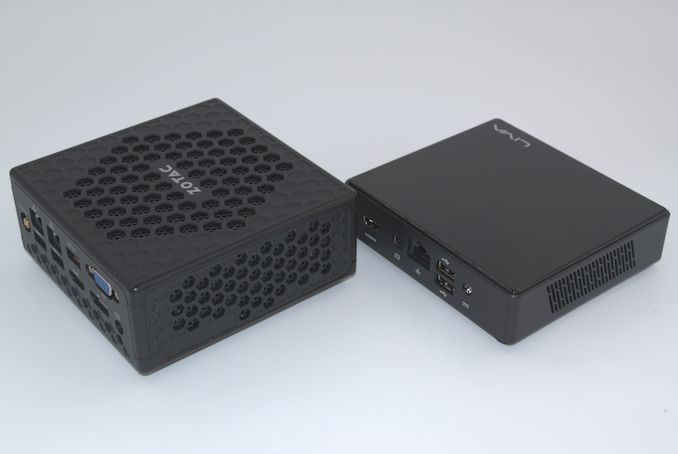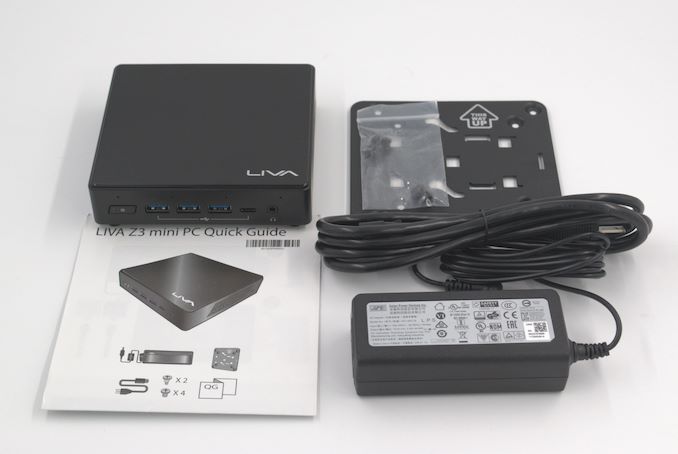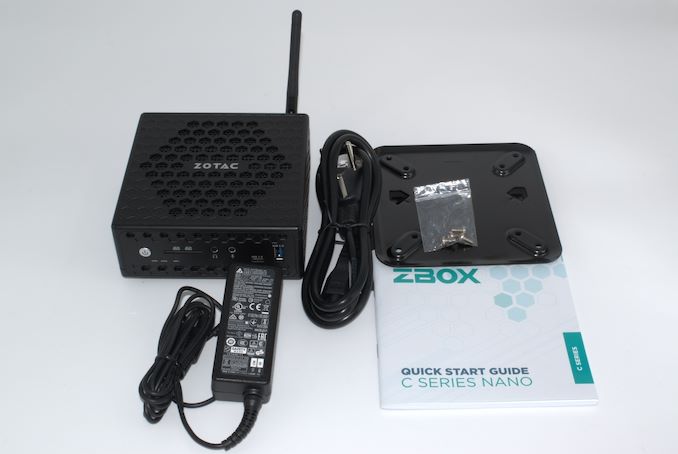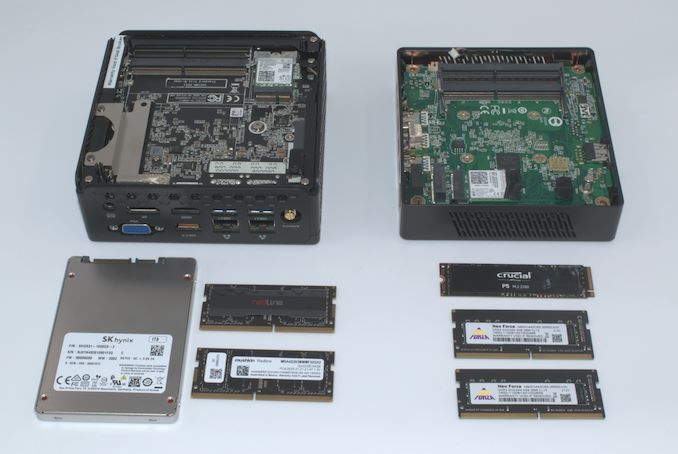Jasper Lake Fanless Showdown: ECS LIVA Z3 and ZOTAC ZBOX CI331 nano UCFF PCs Review
by Ganesh T S on July 8, 2022 8:30 AM EST- Posted in
- Systems
- ZOTAC
- Fanless
- ECS
- Passive Cooling
- UCFF
- Mini-PC
- Jasper Lake

Intel's Jasper Lake series of products (based on the Tremont microarchitecture) was launched in early 2021. Since then, we have seen a steady stream of notebooks and motherboards / mini-PCs based on those processors getting introduced in the market. Ultra-compact form-factor (UCFF) machines based on the Atom series offer attractive entry-level options in the NUC domain. Their low-power nature also lends itself to passively cooled designs.
Intel's Jasper Lake SKUs are a follow-up to Gemini Lake. Back in 2018, we had reviewed two different Gemini Lake UCFF PCs - the actively cooled June Canyon NUC from Intel, and the passively cooled LIVA Z2 from ECS. For Jasper Lake, we have sourced four different UCFF PCs - two passively cooled systems using 6W TDP processors, and two actively cooled ones using 10W TDP processors.
Today's article provides a detailed look into the performance and features of the two passively cooled systems - the ECS LIVA Z3 and the ZOTAC ZBOX CI331 nano. Both of them are based on 6W TDP processors, with slight variations in frequency and iGPU capabilities. The two vendors have also adopted different approaches to the power limits, making for unexpected performance impacts. In addition to an investigation into the capabilities offered for traditional PC workloads, we also go deep into the thermal design to provide insights into what makes fanless systems satisfy user requirements.
Introduction and Product Impressions
Intel's Apollo Lake SoCs (Goldmont-based) introduced in 2016 were quickly followed by Gemini Lake (Goldmont Plus) in late 2017. However, the delays related to 10nm manufacturing resulted in a significant gap before the Tremont-based Jasper Lake products made an appearance in early 2021. Compared to Gemini Lake, the new Jasper Lake products have improved CPU performance (Intel claims a 33% uplift) with an updated microarchitecture and larger caches. The integrated GPU is also clocked higher with additional EUs. Intel On the system front, faster expansion options are available, with up to 8 Gen 3 lanes (compared 6 Gen 2 lanes in Gemini Lake), 14 USB ports (up to 10 Gbps) (compared to 8 ports up to 5 Gbps in Gemini Lake). Jasper Lake also integrates a Wireless-AX MAC, allowing for cost-effective systems with Wi-Fi 6 support. Manufacturers can adopt or take advantage of these features in a varied manner to bring differentiated products into the market.
Similar to our Apollo Lake (Intel Arches Canyon and ECS LIVA Z) and Gemini Lake (Intel June Canyon and ECS LIVA Z2) experiments, we got hold of multiple Jasper Lake UCFF PCs for evaluation. Today's review is focused on the two fanless systems - the ECS LIVA Z3 and the ZOTAC ZBOX CI331 nano.
A quick comparison of the ECS LIVA Z3 and the ZBOX CI331 nano reveal the following differentiation aspects:
- Support for a 2.5" SATA disk drives in the ZBOX, not available in the LIVA Z3
- Support for a M.2 2280 NVMe SSD in the LIVA Z3, not available in the ZBOX
- Integrated 128GB eMMC in the LIVA Z3, not available in the ZBOX
- VGA display output (total of 3, including HDMI and DisplayPort) available in the ZBOX, while the LIVA Z3 has only two (HDMI and mini-DP)
- Dual LAN and SDXC/SDHC card reader included in the ZBOX, while the LIVA Z3 has only a single LAN port
- Integrated quad-microphone (DMIC) array in the LIVA Z3, while the ZBOX has separate headphone and microphone jacks.
The ZBOX also uses a more advanced WLAN solution (Intel Wireless-AC 9462 with Bluetooth 5.1) compared to the LIVA Z3 (Intel Wireless-AC 3165 with Bluetooth 4.2). The form-factors are also slightly different, with the absence of 2.5" disk drive support in the LIVA Z3 enabling it to be slimmer.
The LIVA Z3 comes in multiple flavors - an OS-less version with 4GB of RAM and 128GB eMMC for $220, and another variant with Windows 10 Pro bundled for $250. The ZBOX CI331 nano also has a similar bundle, though the barebones version is sans memory or eMMC. Pricing comes in at $260 for the barebones version. The reasons for the pricing premium will become apparent as we proceed through the review.
The use-cases for the two systems are manifold, with the fanless nature making them suitable for digital signage, kiosks, retail applications, etc. The dual LAN feature in the ZBOX makes it additionally attractive for networking applications.
The system packages delivered by ECS and ZOTAC are similar - both include a 65W power adapter (19V @ 3.42A), and include VESA mounts. The ZOTAC package includes a separate WLAN antenna, and additional thermal pads for the SATA drive.
The ECS LIVA Z3 review sample came with both memory slots occupied (2x 4GB DDR4-2666 SODIMMs). The board also includes 128GB eMMC, but that is insufficient for our benchmarking purposes. We took advantage of the M.2 NVMe slot to install a Crucial P5 M.2 2280 NVMe SSD in the system as the primary drive. The full specifications of the ECS LIVA Z3 sample as tested are provided in the table below.
| ECS LIVA Z3 Specifications (as tested) |
|
| Processor | Intel Pentium Silver N6000 Jasper Lake 4C/4T, 1.1 - 3.3 GHz Intel 10nm, 4MB L3, 6W |
| Memory | Gold Key Tech. Neo Forza NMSO440D85-2666E DDR4-2666 SODIMM 19-19-19-43 @ 2666 MHz 2x4 GB |
| Graphics | Intel UHD Graphics (32EU @ 350 - 850 MHz) |
| Disk Drive(s) | Crucial P5 CT1000P5SSD8 (1 TB; M.2 2280 PCIe 3.0 x4 NVMe;) (Micron 96L 3D TLC; Micron DM0182 Controller) Biwin BWCTASC41P128G (128GB; eMMC) |
| Networking | 1x GbE RJ-45 (Realtek RTL8168/8111) Intel Wireless AC-3165 (1x1 802.11ac - 433 Mbps) |
| Audio | Realtek ALC897 (3.5mm Headphone Jack in Front Panel with Quad-Mic Array Digital Microphon) Digital Audio and Bitstreaming Support over HDMI and DisplayPort Outputs |
| Video | 1x HDMI 2.0a 1x mini-DP 1.4a |
| Miscellaneous I/O Ports | 3x USB 3.2 Gen 1 Type-A (Front) 1x USB 3.2 Gen 2 Type-C (Front) 2x USB 2.0 Type-A (Rear) |
| Operating System | Windows 11 Enterprise (22000.708) |
| Pricing | (Street Pricing on June 21st, 2022) US $232 (w/eMMC, 4GB DDR4, and OS) US $352 (as configured) |
| Full Specifications | ECS LIVA Z3 Specifications |
The ZOTAC ZBOX CI331 nano was a barebones sample, similar to the CI662 nano we reviewed last year. Zotac's C series eschews M.2 slots and opts instead for the traditional 2.5" SATA drive bay. The SSD used in that review (SK hynix Gold S31) was reused in the CI331 nano. The DRAM option was more tricky. The Jasper Lake platform officially supports DDR4-2933. Having a large number of DDR4-2933 / DDR4-3000 / DDR4-3200 SODIMMs collected (starting from the Skylake days), I was hopeful of getting one of those early high-frequency SODIMMs to operate at DDR-2933 speeds in the CI331 nano. Unfortunately, they all defaulted to DDR-2400, and the BIOS was not too helpful in terms of allowing modification of DRAM timings. Only recent DDR4-2933+ SODIMMs were able to operate at DDR-2933 in the system - unfortunately, I only had 32GB SODIMMs in hand from the recent batches. In the end, the ZBOX CI331 nano was outfitted with 2x 32GB DDR-2933 Mushkin Redline SODIMMs for a total of 64GB of RAM - way higher than the officially specified 16GB maximum memory capacity of the Jasper Lake platform. Fortunately, the system worked flawlessly through our benchmarking routines despite this wild configuration. The full specifications of the ZOTAC ZBOX CI331 nano sample as tested are provided in the table below.
| ZOTAC ZBOX CI331 nano Specifications (as tested) |
|
| Processor | Intel Celeron N5100 Jasper Lake 4C/4T, 1.1 - 2.8 GHz Intel 10nm, 4MB L3, 6W |
| Memory | Mushkin MR[ABC]4S293MMMF32G DDR4-2933 SODIMM 21-21-21-47 @ 2933 MHz 2x32 GB |
| Graphics | Intel UHD Graphics (24EU @ 350 - 850 MHz) |
| Disk Drive(s) | SK hynix Gold S31 (1 TB; 2.5" SSD SATA III;) (SK hynix 72L 3D TLC; SK hynix Quartz SH87830CC Controller) |
| Networking | 2x GbE RJ-45 (Realtek RTL8168/8111) Intel Wireless AC-9462 (1x1 802.11ac - 433 Mbps) |
| Audio | ESS Tech ES9270 USB DAC (3.5mm Audio Jacks in Front Panel) Digital Audio and Bitstreaming Support over HDMI and DisplayPort Outputs |
| Video | 1x HDMI 2.0b 1x DisplayPort 1.2 1x VGA |
| Miscellaneous I/O Ports | 1x USB 3.2 Gen 1 Type-A (Front) 1x USB 3.2 Gen 1 Type-C (Front) 2x USB 3.2 Gen 2 Type-A (Rear) 1x USB 3.2 Gen 1 Type-A (Charging / Rear) 1x SDXC/SDHC UHS-I Card Reader Slot (Front) |
| Operating System | Windows 11 Enterprise (22000.708) |
| Pricing | (Street Pricing on July 6st, 2022) US $260 (barebones) US $616 (as configured) |
| Full Specifications | ZOTAC ZBOX CI331 nano Specifications |
Our next section goes into the details of the thermal design and the need for a thorough look at it.














52 Comments
View All Comments
xol - Friday, July 8, 2022 - link
Correction (?)Neither of these reviewed products has a Intel UHD Graphics 605 .. (that's a 14nm Gemini part with 18 EU eg here https://ark.intel.com/content/www/us/en/ark/produc...
.. Intel seems to have not publisher a 'number' for this iGPU and seems to distinguish them by number of EU eg Jasper Lake 24EU eg https://www.intel.co.uk/content/www/uk/en/products...
xol - Friday, July 8, 2022 - link
Somehow messed up the link :UHD 605 https://ark.intel.com/content/www/us/en/ark/produc...
mode_13h - Friday, July 8, 2022 - link
Thanks for your coverage of fanless mini-PCs. However, I really wish you'd include something with "big cores", so we can get a sense of the scale of performance difference between them and Tremont.Another nice-to-have would be at least a few benchmarks including a Raspberry Pi 4. However, it has serious thermal throttling issues, unless it's actively cooled or you use a substantial passive cooling solution.
mode_13h - Friday, July 8, 2022 - link
I guess the ideal comparison would be a Tiger Lake-based system, since that's the same vintage and similar manufacturing tech as Tremont. Probably much harder to find in a fanless mini-PC, unless we're talking about an industrial PC, but I'd love even to see a comparison between two NUCs: Tiger Lake vs. Tremont.mode_13h - Friday, July 8, 2022 - link
Or maybe Ice Lake would be even better, but did they make Ice Lake-based NUCs?abufrejoval - Thursday, July 14, 2022 - link
Yes, Tiger Lake NUCs were made, but also very hard to come by: I have both.In a way they are perfect to showcase the benefit of E/P cores …in the case of Intel: AMD is really another story.
The two NUCs look nearly identical on the outside, but inside they are very different beasts.
For starters: The Tiger Lake NUC11 (i7-1165G7 with 96EU Xe iGPU) is configured with a 64 Watt PL2, a rather long TAU and even the PL2 is 30 Watts by default, I believe. There is a reason it comes with a 90 Watts power brick! I changed PL2 to 50, TAU to 10 seconds and PL1 to 15 Watts to ensure the fan would never howl they way it does with the defaults.
I’ve seen HWinfo report a 5GHz maximum clock, but 4.7GHz is the official top speed. It’s at 64 Watts and near 5GHz clocks that I have measured 1707/5808 Geekbench 4 results on Linux (always a bit faster than on Windows). Jasper Lake doesn’t quite play in the same league at 781/2540 using 3.3 GHz and 10 Watts. In Watts/compute power Tiger Lake looks rather worse than Jasper Lake, but when it comes to rendering a complex web page or recalculating a giant Excel sheet, its sprinting power certainly has it appear much faster.
At 64 Watts the Tiger Lake is a desktop CPU, shoehorned into mobile power envelopes. And when it’s constrained to the levels that passive cooling can manage (see the Supermicro SYS-E100-12T-H review here), it really struggles to deliver that performance. The great thing about the Tiger Lake NUC is that you can change PL1, PL2 and TAU to pretty much anything you want and when you set it to the 10 Watts the Jasper Lake gets to use as an absolute maximum, it starts to do rather badly.
Some of that is because the iGPU always gets preference, leaving close to nothing to the CPU. But some of that is that the remaining power budget forces very low frequencies, where the big Core CPU loses against the Atom cores running at a full speed with these Watts.
Jasper Lake, like all the other Atoms since the J1900, never slows down. I’ve never seen it drop below its “Turbo” clock unless idle, even on a mix of Prime95 and Furmark, and I’ve never seen it exceed 10 Watts of combined CPU+GPU power consumption either.
I also have two Ryzen 5800U based notebooks (1443/7855 on Geekbench4), one of which can be switched between 15 and 28 Watts of TDP. When Tiger Lake and Zen 3 are strictly set to the same power levels, Tiger Lake has to run much slower even with half the cores: Ryzen beats it with a much smaller energy footprint per core. But with Tiger Lake left at the default NUC settings (which a battery powered notebook could not support), its four cores will beat an eight core Zen 3 at 15 Watts in Geekbench, which luckily never seems to exceed TAU.
Intel needs E/P because P cores need too much power at the clock rates they require to beat a Ryzen core, and only with E cores they can hit the efficiency of Zen cores in fully multi-threaded loads.
mode_13h - Thursday, July 14, 2022 - link
Wow, another awesome post! Thanks for taking the time to relate your findings. Very interesting!> the iGPU always gets preference, leaving close to nothing to the CPU.
Very key point, but also one that Intel could conceivably address, to some extent, in future BIOS updates. Not that they're likely to, if it had been on the market for a while when you tested, but it's conceivable.
> in Geekbench, which luckily never seems to exceed TAU.
Another great point! I have never run Geekbench myself, and I haven't noticed reviewers mention this key detail.
Foeketijn - Saturday, September 3, 2022 - link
Don't you want to write for Anand?stanleyipkiss - Friday, July 8, 2022 - link
Zotac makes a fanless zbox with a 1165G7xol - Friday, July 8, 2022 - link
Benches I've seen suggest both are very similar in multi to a i3 low power Skylake eg a ie-6100T (2core 4 thread very common thin client chip) - the gfx capability also seems also a close match for the 24EU part [probably a very similar part with improved HEVC support] (the 32EU N6000 should be better)For single threaded the old Skylake is ~+50% faster., and from Skylake to Alder Lake it's nearly 2x , so nearly 3x from N5100 to i5-12500 for single thread
I have an old fanless Atom Z3735F (22nm) and these new SoCs are a impressive step up (~7x both cpu and gpu) -- I think the Pi Model B latest is very roughly 2x better than that nut no where near the 5100T in any metric.
tldr both benches would have been a wash one way of the other.